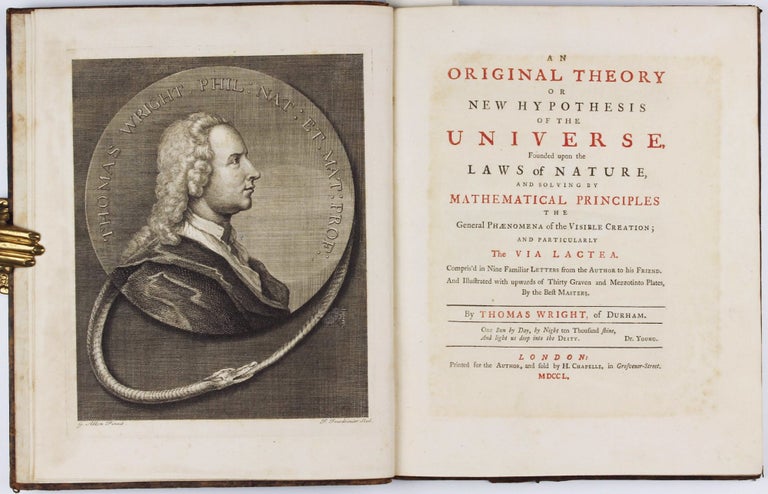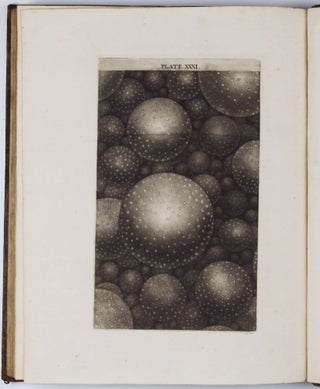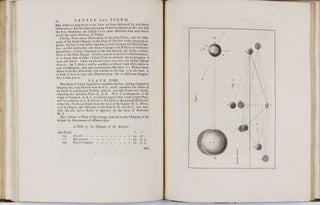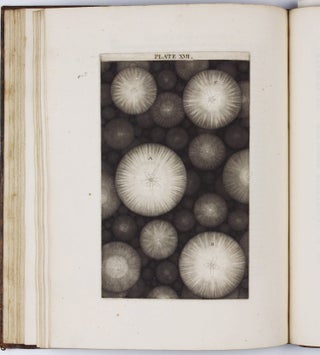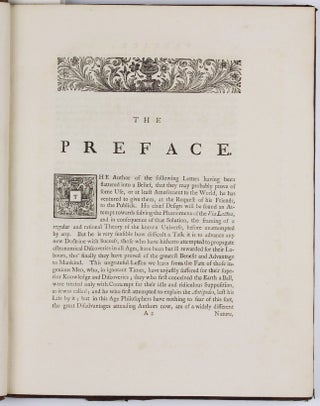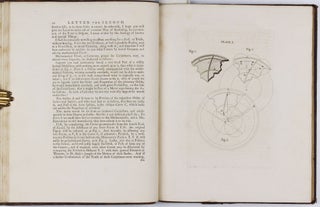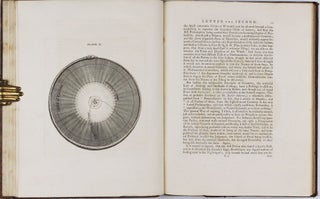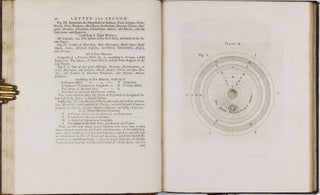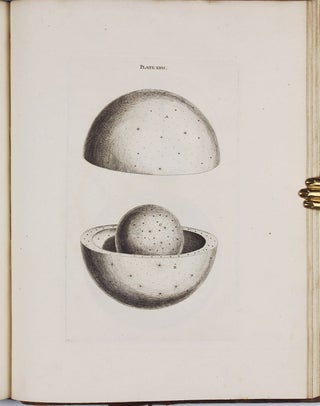Foundation work of cosmology
An original theory or new hypothesis of the universe, founded upon the laws of nature, and solving by mathematical principles the general phaenomena of the visible creation; and particularly the Via Lactea.
London: Printed for the Author, and sold by H. Chapelle, 1750.
1st Edition. Hardcover. Near Fine. Item #002600
4to (286 x 226 mm). viii, [4], 84 pp. Engraved portrait frontispiece* of the author by Fourdrinier after G. Allen, title printed in red and black, 32 engraved plates (2 folding, 8 in mezzotint), wood-engraved initials, head- and tailpieces, with the errata- and list of subscribers leaves, without the final blank. Contemporary mottled calf, spine with 5 raised bands richly gilt in compartments and with gilt-lettered morocco label in first compartment (boards and extremities rubbed, corners bumped and scuffed). Internally very little age-toned, minor spotting to a few leaves only, light offsetting from frontispiece on title-page, tiny hole in plate 28 from paper flaw not affecting image. Provenance: inscribed monogram L.C.B. to front pastedown. An outstanding, bright and crisp copy with very broad margins. ----
RARE FIRST EDITION of this attempt at reconciling religion and science and establishing an understanding of the Milky Way. A book of considerable importance in the history of science. Wright first explained the Milky Way and the nebulae as external galaxies and provided the basis for the theories on the universe by Kant, Herschel and Laplace (see Paneth for a detailed discussion of the connection between Wright and Kant).
Wright, a teacher of navigation and a land surveyor by profession, "hypothesized a 'divine center' of the universe, corresponding to a gravitational center around which the sun and other stars orbited. He also proposed, as a possible explanation for the visual phenomenon of the Milky Way, a model of the universe in which the orbiting stars formed a flattened ring, this hypothesis caused Immanuel Kant, who did not realize that Wright's 'center' was supernatural, to credit Wright with originating a disk-shaped model of the galaxy" (Norman).
"The title [of Wright's book] already indicates that here he is aiming much higher: an original theory or new hypothesis of the Universe, solving particularly the phenomenon of the Milky Way. Let us state at the outset that this claim is not at all exaggerated. For the first time in the history of astronomy the view is expressed here that the fixed stars are not distributed at random in space, but mainly concentrated in a flat disk; that the Sun with his planets is situated somewhere not too far from the disk's centre, and that, therefore, for us many more stars are visible in the direction of the disk's plane than in any other. As they are too numerous to be seen separately they appear to the naked eye as a luminous circle on the sky - the Milky Way. The explanation given here by Wright of the galaxy as an optical phenomenon, following from, and thus revealing, a disk-like distribution of the visible stars, is contained in the seventh letter, and illustrated by a diagram. The wording of the crucial paragraph is rather clumsy and involved, and the author at once proceeds to much wilder speculations in which the Universe appears as a combination of concentric shells ; the Eye of Providence is seated in the Centre and becomes, therefore, clearly visible on the plate depicting the Universe in cross section. It was, perhaps, a blessing in disguise that the very careful abstractor who reviewed the book for a Hamburg periodical, the Freys Urtheile und Nachrichten zum Aufnehmen der Wissenschaften und der Historie überhaupt (Year 8, Part I, Jan. 1, 1751) was, to his regret, unable to include the copper plate prints and had consequently to omit these passages which could not be presented without reference to the diagrams. Wright's convincing explanation of the nature of the galaxy stands out all the clearer in the translator's account. It was this summary which Kant happened to read, and which became the starting point of his own cosmological speculations" (Paneth, pp. 74-75).
*The engraved portrait frontispiece is not called for in this work, but is part of Wright's earlier work Clavis coelestis (London, 1742).
References and Literature: Norman 2265; DSB XIV, p. 518-9; Honeyman 3143; Gingerich, Rara Astronomica 53; Hoskin, J. for the History of Astronomy, 1, pp. 44-52; F. A. Paneth, Thomas Wright of Durham and Immanuel Kant. In: The Observatory, Vol. 64, p. 71-82 (1941).
Price: 32,000 € * convert currency
Delivery time up to 10 days. For calculation of the latest delivery date, follow the link: Delivery times
Lieferzeit max. 10 Tage. Zur Berechnung des spätesten Liefertermins siehe hier: Lieferzeiten


